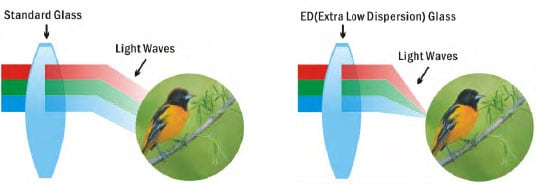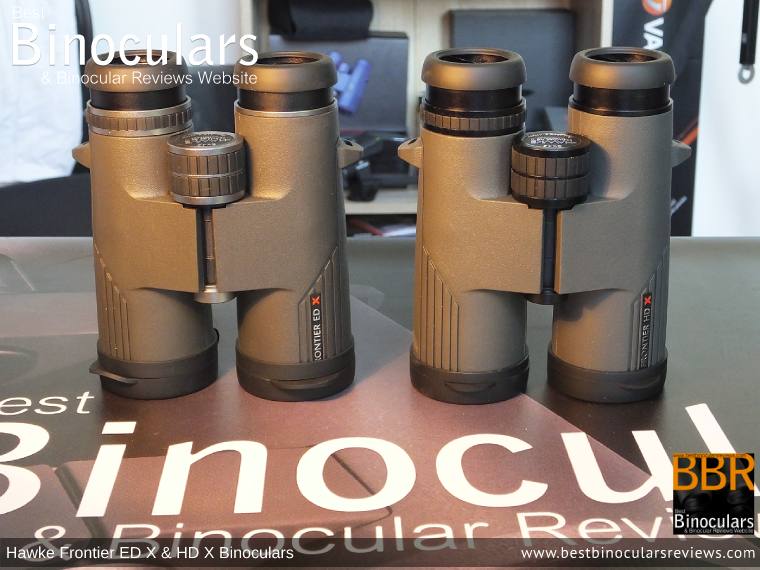Is Extra Low Dispersion Glass worth the extra cost?
Today’s question comes from someone wanting to find out if their money is being well spent on binoculars that use ED Glass (Extra Low Dispersion Glass):
Question
I have read your reviews and all your notes on the web page and spend hours searching for a suitable and not least affordable binocular… I know a LOT about binoculars now!
I am interested in the Hawke Frontier 8x42 HD X however, how much better can I expect the ED version (Hawke Frontier 8x42 ED X to be, compared to the regular HD X model?
Is it worth the money and the waiting for the ED version? This is my first time buying a binocular and I have no clue. There are no shops dealing Hawke binoculars in my town, so I have no option to try before purchasing. Can any one help?
Hawke Frontier 8x42 ED X on the Left & the Hawke Frontier 8x42 HD X on the Right
Answer
Not that long ago and ED glass was the sole domain of the super “alpha” binocular, reserved and found only on the very best and most expensive binoculars.
But now it seems that just about every other binocular that I review uses Extra Low Dispersion Glass and whilst they are generally still more expensive than the equivalent standard glass versions, the price difference has most certainly been getting less and less.

What does ED glass do?
The illustration above used by Vanguard shows basically what ED extra low dispersion glass (ED glass) does.
 Compared to “standard” low dispersion optical glass, it allows for a wider range of options when designing the objective lens and thus they can if used correctly control and minimize aberrations, especially chromatic aberration by concentrating and directing the wavelength of light more effectively towards your eyes. The result of this is that we then see less color fringing around the edges of objects in the view.
Compared to “standard” low dispersion optical glass, it allows for a wider range of options when designing the objective lens and thus they can if used correctly control and minimize aberrations, especially chromatic aberration by concentrating and directing the wavelength of light more effectively towards your eyes. The result of this is that we then see less color fringing around the edges of objects in the view.
For more details take a look at my Complete Guide to ED Glass in Binoculars.
ED vs Non-ED Glass Binoculars
The amount of Chromatic Aberration and thus the level of Colour Fringing that you see through a standard glass binoculars depends on a number of factors including the level of magnification and the dispersion of the glass.
But good quality normal low dispersion glass binoculars will still usually use high quality “standard” optical glass and coatings and the amount of colour fringing will be often be very minimal anyway.
In these cases, it can actually be quite difficult to see any colour fringing even when you are looking for it – but if you carefully look around the edges of light coloured object that should have sharp edges against a dark background it will become noticeable, but you would generally not notice this when using your binoculars normally and not thinking about it.
Colour Fringing is usually much easier to notice on cheaper binoculars that use poor quality glass that has a higher dispersion.
To make things even more complicated, I have often seen the same level of color fringing on binoculars that have ED glass than the a good pair of binoculars that does not.
This is almost always at the cheaper end of the market and here is why: Simply adding an ED glass element to your lenses will not make it produce less color fringing, you have to take the whole optical path as it passes through the instrument into consideration. So in low cot bins, where the level of expertise in manufacturing and optical components used is lower, the difference it makes is less or I’d even go as far as saying none.
I would go on to say that ED Glass can make a difference, but the amount of difference depends on the quality of ED binocular and the pair that you are comparing them against.
At the cheaper end of the spectrum you will only probably notice it, if you were to first look through a binocular that had very bad colour fringing and then look through the cheap ED Binocular.
However from the mid-high level up to high end instruments, you most certainly do see less color fringing on those that use ED glass.
So is preventing colour fringing worth the extra cost of ED Glass?
Answering this question is a hard one and will depend on what you think is a lot of money and just how much importance you put down to getting the best possible view.
I think my general advice would be as always: Stay away from very cheap optics, even if they do have “ED Glass” and get the best quality binocular that you can comfortably afford.
Hawke Frontier HD & ED X Binoculars
Being more specific and returning to your question on the Hawke Frontier Binoculars:
The amount of color fringing on the “standard” HD X version was very minimal compared to others in this class and when i tested them I thought that they were very good anyway.
I did think that the ED X version showed less color fringing, but this was only when I compared them side-by-side and really examined the view by deliberately looking very closely along the edges of very high contrasting subjects (a telephone wire against a bright blue sky).
To be honest, on both you can only really notice it if you are actually looking for it and so won’t annoy you when using your binoculars normally.
So my advice is to get the standard version if the amount of money you save is important to you, or get the ED version if you want the satisfaction of knowing that chromatic aberration has been reduced and therefore the quality of your view has improved … even if it is just by a fraction.

 Article | Posted by Best Binocular Reviews
Article | Posted by Best Binocular Reviews 

 Categories:
Categories:  Tags:
Tags: 
